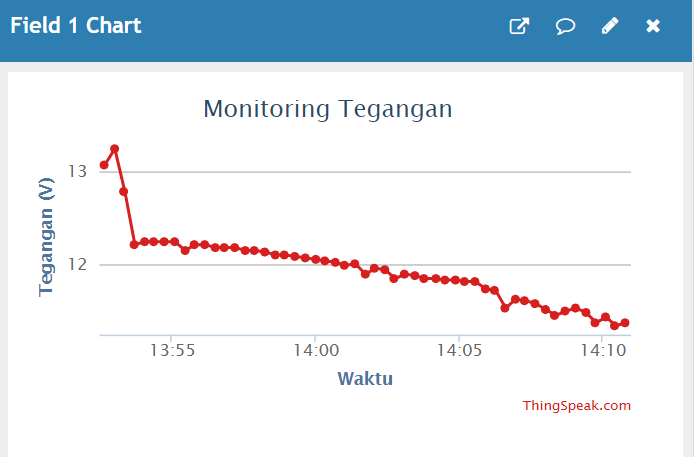Prototipe Sistem Pompa Air Tenaga Surya dengan Monitoring Tegangan Berbasis Internet of Things (IoT)
DOI:
https://doi.org/10.12928/biste.v3i3.4767Keywords:
Panel Surya, Tegangan, Pompa Air, Thingspeak, Internet of Things (IoT)Abstract
Several types of alternative energy are geothermal, biogas, wind energy, micro hydro and solar energy. Among these alternative energies, solar energy is the most potential energy to be utilized in Indonesia. A solar energy water pump system with a battery is a water pump that utilizes solar energy into electrical energy that is stored in batteries. The energy in the solar panels is stored in the battery as a source of electrical energy to pump water through the solar charge controller. In this study, monitoring the pump battery voltage remotely, monitoring using the Internet of Things (IoT) method by displaying it on the thingspeak website. The solar panel has a power of 10 Watts. Testing on the whole tool using panels and without using panels there are differences from these experiments. With a time of 10 minutes the initial voltage of the experiment using the panel is 13.24V and the final voltage is 11.90V, consuming 1.34V. Experiments without using a panel with a starting voltage of 12.09V and a final voltage of 10.48V, consuming 1.61V. In both experiments there is a difference of 0.27V, in the test using the panel charging occurs, so that it takes longer to reduce the power to the battery.
Beberapa jenis energi alternatif adalah panas bumi, biogas, energi angin, mikro hidro dan energi surya. Di antara energi alternatif tersebut, energi matahari merupakan energi yang paling potensial untuk dimanfaatkan di Indonesia. Sistem pompa air energi surya dengan baterai adalah pompa air yang memanfaatkan energi matahari menjadi energi listrik yang disimpan di baterai. Energi pada panel surya di simpan ke baterai sebagai sumber energi listrik untuk pompa air melalui solar charge controller. Pada penelitian ini memantau tegangan baterai pompa dari jarak jauh, pemantauan menggunakan metode Internet of Things (IoT) dengan menampilkan pada website thingspeak. Panel surya memiliki daya sebesar 10 Watt. Pengujian pada alat keseluruhan dengan menggunakan panel dan tanpa menggunakan panel terdapat perbedaan dari percobaan tersebut. Dengan waktu 10 menit tegangan awal percobaan menggunakan panel 13,24V dan tegangan akhir 11,90V, menghabiskan sebanyak 1,34V. Percobaan tanpa menggunakan panel tegangan awal 12,09V dan tegangan akhir 10,48V, menghabiskan sebanyak 1,61V. Pada kedua percobaan tersebut terdapat selisih 0,27V, pada pengujian menggunakan panel terjadi pengisian daya, sehingga lebih lama pengurangan daya pada baterai.
References
PGE, “Energi Panas Bumi Untuk Kemandirian Negeri, Laporan Tahunan PT. PGE tahun 2018,” pp. 1–484, 2018. https://www.pge.pertamina.com/Uploads/966fa8da-1bac-438b-95ea-939b12326de1_ar-pge-website-rev.pdf
Rosalina and E. Sinduningrum, “Penerapan Pembangkit Listrik Tenaga Surya di Lahan Pertanian Terpadu Ciseeng Parung-Bogor,” Semin. Nas. Teknoka, vol. 4, pp. 74–83, 2019. https://journal.uhamka.ac.id/index.php/teknoka/article/view/4188
Subandi and S. Hani, “Pembangkit Listrik Energi Matahari Sebagai Penggerak Pompa Air Dengan Menggunakan Solar Cell,” J. Teknol. Technoscientia, vol. 7, no. 2, pp. 157–163, 2015. https://doi.org/10.1016/B978-1-85617-457-2.X5000-8
P. A. Wahono, S. Komar, and F. R. Suwardi, “Evaluasi Pompa Esp Terpasang Untuk Optimasi Produksi Minyak Pt. Pertamina Asset I Field Ramba,” J. Tek. Kim., vol. 21, no. 1, pp. 57–63, 2015. http://ejournal.ft.unsri.ac.id/index.php/JTK/article/view/515
Safrizal, “Rancangan Panel Surya Sebagai Sumber Energi Listrik Pada Gedung Fakultas Sains Dan Teknologi Unisnu Jepara," J. Disprotek, vol. 8, no. 2, pp. 75–81, 2017. https://ejournal.unisnu.ac.id/JDPT/article/view/544
S. Haryadi and G. R. F. Syahrillah “Rancang Bangun Pemanfaatan Panel Surya Sebagai Charger Handphone Di Tempat Umum,” Tek. Mesin UNISKA, vol. 02, no. 02, pp. 114–120, 2017. https://core.ac.uk/download/pdf/229027901.pdf
A. Julisman, I. D. Sara, and R. H. Siregar, “Prototipe Pemanfaatan Panel Surya Sebagai Sumber Energi Pada Sistem Otomasi Stadion Bola,” Jurnal Karya Ilm. Tek. Elektro, vol. 2, no. 1, pp. 35–42, 2017. http://e-repository.unsyiah.ac.id/kitektro/article/view/6756
M. Faridha and M. D. Yusuf Saputra, “Analisa Pemakaian Daya Lampu Led Pada Rumah Tipe 36,” J. Teknol. Elektro, vol. 7, no. 3, pp. 193–198, 2016. https://doi.org/10.22441/jte.v7i3.898
R. D. Listianto, S. Sunardi, and R. D. Puriyanto, “Monitoring Tegangan Baterai Lithium Polymer pada Robot Sepak Bola Beroda secara Nirkabel,” Bul. Ilm. Sarj. Tek. Elektro, vol. 1, no. 1, pp. 1–8, 2019. https://doi.org/10.12928/biste.v1i1.826

Downloads
Published
How to Cite
Issue
Section
License
Copyright (c) 2022 Alfan Habibillah, Alfian Ma'arif

This work is licensed under a Creative Commons Attribution-ShareAlike 4.0 International License.
Authors who publish with this journal agree to the following terms:
- Authors retain copyright and grant the journal right of first publication with the work simultaneously licensed under a Creative Commons Attribution License that allows others to share the work with an acknowledgment of the work's authorship and initial publication in this journal.
- Authors are able to enter into separate, additional contractual arrangements for the non-exclusive distribution of the journal's published version of the work (e.g., post it to an institutional repository or publish it in a book), with an acknowledgment of its initial publication in this journal.
- Authors are permitted and encouraged to post their work online (e.g., in institutional repositories or on their website) prior to and during the submission process, as it can lead to productive exchanges, as well as earlier and greater citation of published work (See The Effect of Open Access).
This journal is licensed under a Creative Commons Attribution-ShareAlike 4.0 International License.


